Overview of Network Data Backup
Definition of Network Data Backup
Network Data Backup refers to the process of creating and storing duplicate copies of your important business data on a network or cloud-based storage system. This enables you to protect your data from unforeseen events such as hardware failures, human errors, or cyber attacks. By regularly backing up your data, you ensure that even if one copy is lost or corrupted, you can easily retrieve it from another location.
Importance of Network Data Backup
Network Data Backup is crucial for businesses of all sizes. It provides a safety net for your valuable data, safeguarding it against potential data loss and minimizing the risk of downtime. In the event of a disaster, such as a fire or a natural calamity, having a network data backup system in place ensures business continuity and allows you to recover quickly without significant disruptions. It also provides peace of mind, knowing that your data is stored securely and can be restored whenever needed.
Types of Network Data Backup
There are several types of network data backup options available. These include full backup, incremental backup, and differential backup. Full backup involves creating a complete copy of all your data, while incremental backup only includes the changes made since the last backup. Differential backup, on the other hand, stores the changes made since the last full backup. Each type has its own advantages and disadvantages, so it’s important to choose the one that best suits your business needs.
By implementing network data backup solutions, you can ensure the protection and availability of your critical business data. This proactive approach helps to safeguard your information, minimize downtime, and ultimately, preserve your company’s integrity and success.
Benefits of Network Data Backup
Network data backup is essential for safeguarding your valuable data and ensuring it can be easily restored in the event of a disaster or accidental loss. By regularly backing up your data to a remote server, you can protect it from hardware failure, cyber attacks, or natural disasters like fires or floods. Here are several notable benefits of using network data backup:
Data Protection
Network data backup provides an additional layer of protection for your data. By creating multiple copies and storing them off-site, you can minimize the risk of data loss due to hardware failures, theft, or human error. In the event of data corruption or accidental deletion, you can easily access the most recent backup and restore your valuable files.
Disaster Recovery
In the unfortunate event of a disaster, such as a flood or fire, network data backup ensures that your critical files and information are not permanently lost. By storing your backups at a remote location, you can quickly recover your data and resume your business operations without incurring substantial downtime.
Reduced Downtime
Network data backup allows for efficient and timely data recovery, thereby reducing downtime. In the event of a system failure, you can quickly restore your data from the backup and continue your workflow seamlessly. This minimizes disruptions and helps you maintain productivity.
Business Continuity
With network data backup, you can ensure business continuity even under adverse circumstances. By having a reliable backup system in place, you can quickly recover your data and maintain essential operations, preserving your reputation and customer trust.
By investing in network data backup, you can enjoy peace of mind, knowing that your important data is securely stored and easily recoverable in case of an unforeseen event.
How Network Data Backup Works
Network data backup is a crucial process that ensures the safe and reliable storage of your valuable data. It involves creating copies of your files and storing them securely in a remote location. Understanding how network data backup works can help you protect your data and minimize the risk of losing important information.
Data Selection and Prioritization
The first step in network data backup is to select the files or data that need to be backed up. You have the flexibility to choose specific files, folders, or even entire systems. Prioritization is also important, as it allows you to determine which data is most critical and needs to be backed up first.
Data Compression and Encryption
To optimize storage space and enhance data security, network data backup solutions often employ data compression and encryption techniques. Data compression reduces the file size, making it more efficient to transfer and store. Encryption, on the other hand, protects your data by converting it into unreadable form, ensuring that only authorized individuals can access it.
Scheduling and Backup Policies
To ensure regular backups, you can set up schedules for automated backups. This allows the backup solution to automatically initiate the backup process at predefined intervals, minimizing the risk of data loss. Additionally, backup policies can be established to determine factors such as retention periods and the frequency of backups.
Data Transfer to Backup Storage
Once the backup process is initiated, the selected data is transferred from the source device to the backup storage location. This can be done through various methods, including network transfers or cloud-based solutions. Efficient data transfer mechanisms ensure that the backup process is completed in a timely and reliable manner.
Incremental and Differential Backups
Network data backup often utilizes incremental and differential backup techniques to optimize storage and backup time. Incremental backups only save the data that has changed since the last backup, while differential backups store the data that has changed since the last full backup. These methods help reduce the time and resources required for backups, making the process more efficient.
Backup Verification
To ensure the integrity and reliability of the backed-up data, backup verification is performed. This involves validating the data against the original files to ensure that it has been accurately copied and stored. Verification helps identify any potential errors or discrepancies in the backup, allowing for immediate rectification.
Restoration of Data
In the event of data loss, network data backup provides the means to restore your data. You can retrieve your backed-up files and restore them to their original location or an alternate location, depending on your requirements. This ensures that your critical data can be recovered and your operations can be resumed with minimal interruption.
Understanding how network data backup works empowers you to make informed decisions about protecting your valuable data. By implementing a reliable backup solution and following best practices, you can safeguard your information and have peace of mind knowing that your data is safe and easily recoverable.
Network Data Backup Methods
Backing up your important files and data is crucial to ensure their safety and recoverability in case of any unforeseen circumstances. Network data backup refers to the process of creating duplicate copies of your data and storing them in secure locations. There are several methods available for network data backup, each with its own advantages and considerations.
Local Backup
One commonly used method is local backup. With local backup, you store copies of your data on physical devices such as external hard drives or tapes. This method offers the advantage of quick and easy access to your data, as the backups are stored on-site. However, it may not provide sufficient protection in case of physical damage or theft.
Offsite Backup
Offsite backup involves creating backups of your data and storing them at a separate location. This method ensures that your data remains safe even in the event of a disaster such as fire, flood, or theft. Offsite backup can be achieved by physically transporting backup devices to an offsite location or by utilizing remote backup services.
Cloud Backup
Cloud backup is becoming increasingly popular due to its convenience and scalability. With cloud backup, your data is uploaded to remote servers maintained by a service provider. This method offers the advantage of automatic backups, secure storage, and easy accessibility from anywhere with an internet connection.
Hybrid Backup
Hybrid backup combines multiple backup methods to enhance data protection. It typically involves a combination of local and offsite or cloud backup. Hybrid backup provides the benefits of both on-site and off-site backup, offering quick access to data and ensuring its safety in case of disasters or data loss.
Network data backup is essential for safeguarding your important files and data. By utilizing various backup methods such as local, offsite, cloud, or hybrid, you can ensure the availability and recovery of your data in any situation.
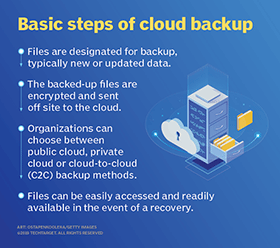
This image is property of cdn.ttgtmedia.com.
## Key Components for Network Data Backup
Network data backup is a crucial aspect of ensuring the safety and security of your valuable business information. It involves creating duplicates of your data and storing them in separate locations, so they can be easily accessed and restored in the event of data loss or system failure. To better understand this process, let’s explore the key components involved in network data backup.
Storage Devices
Storage devices play a vital role in network data backup. These devices, such as external hard drives, tape libraries, or cloud storage solutions, provide the necessary storage capacity to hold your data backups. They are designed to securely store your data for easy retrieval when needed.
Backup Software
Backup software is the backbone of network data backup. It facilitates the process of creating, scheduling, and managing data backups. It allows you to choose the specific files or folders you want to backup and automates the backup process, ensuring that your data is consistently protected.
Network Infrastructure
For network data backup to function effectively, a robust network infrastructure is essential. This includes network devices, such as routers and switches, to facilitate the transfer of data between devices and storage locations. A stable and reliable network infrastructure ensures smooth backup operations.
Data Centers
Data centers serve as secure offsite locations for storing your data backups. These centers are equipped with redundant power supplies, cooling systems, and physical security measures to safeguard your data. Data centers are typically geographically dispersed, minimizing the risk of data loss due to localized disasters.
Security Measures
To ensure the confidentiality, integrity, and availability of your data backups, security measures are implemented. This may include encryption of data during transmission and storage, access controls to limit unauthorized access, and regular monitoring and auditing of the backup system.
By comprehending the key components of network data backup, you can implement an efficient and secure backup strategy for your organization. Protecting your valuable data is vital to the success and continuity of your business operations.
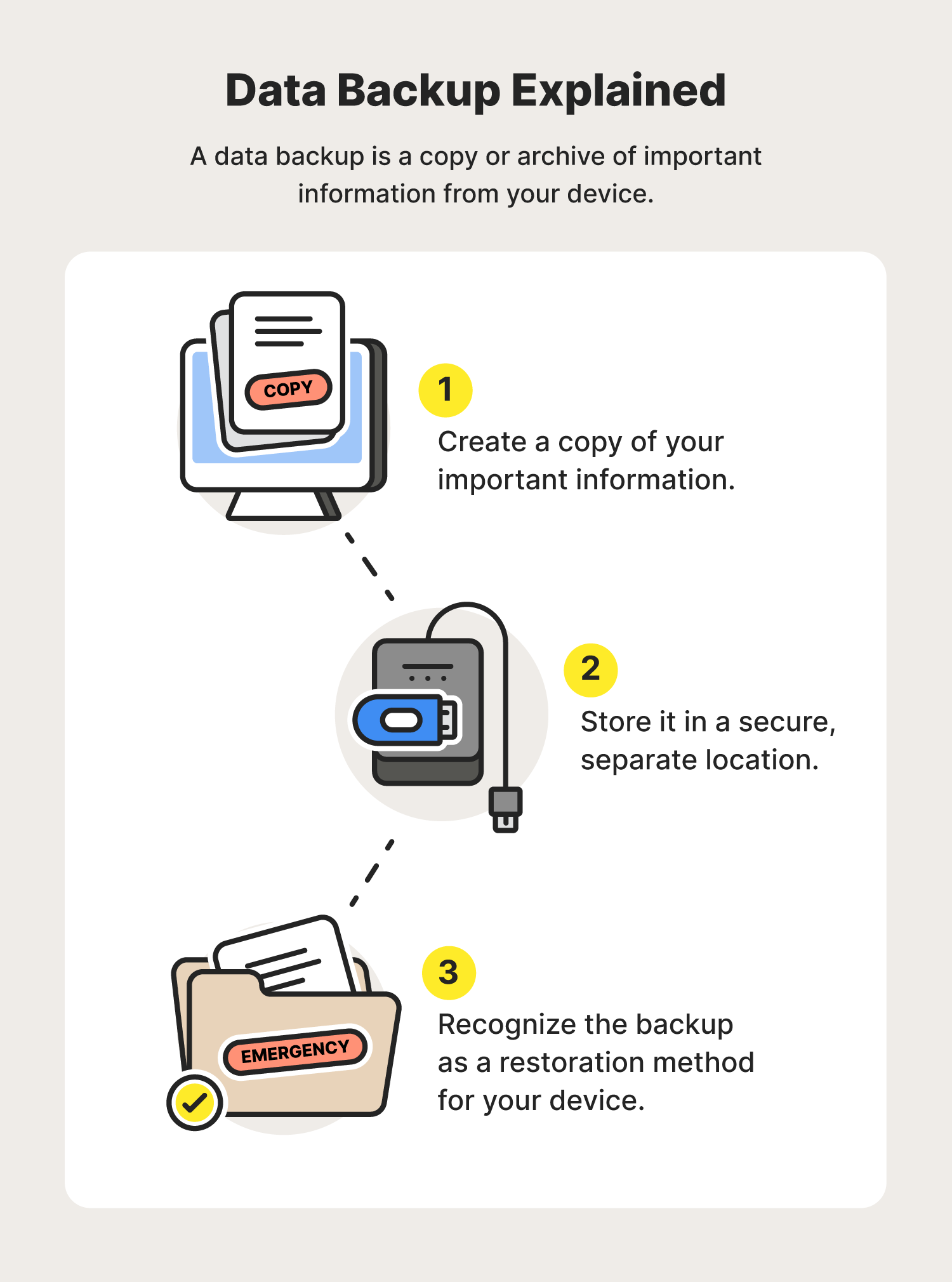
This image is property of us.norton.com.
## Common Challenges in Network Data Backup
Data Volume and Scalability
One of the major challenges in network data backup is dealing with the ever-increasing data volume. As your business grows, so does the amount of data you generate and store. It becomes crucial to find a backup solution that can handle this exponential growth and scale seamlessly without compromising performance or efficiency.
Network Bandwidth
Network bandwidth plays a key role in network data backup. With limited bandwidth, backing up large amounts of data can be a time-consuming and bandwidth-intensive process. It can impact other network activities and cause disruptions. Efficient network data backup solutions employ advanced technologies, such as deduplication and compression, to minimize the data transfer size and optimize bandwidth usage.
Backup Window
To ensure minimal disruption to your business operations, it’s important to have a backup window that accommodates your backup requirements. The backup window is the period during which regular backups are performed. If your backup window is too short, it may not provide enough time for complete backups. Conversely, if it’s too long, it may impact network performance and productivity.
Data Security
Securing your backed-up data is vital to protect it from unauthorized access, breaches, or loss. Network data backup solutions should incorporate robust security measures, including encryption, access controls, and authentication mechanisms, to ensure the confidentiality and integrity of your data.
Cost Considerations
When choosing a network data backup solution, cost considerations are a significant factor. You need to assess the total cost of ownership, including hardware, software, maintenance, and operational costs. Cloud-based backup solutions are often more cost-effective, as they eliminate the need for on-site infrastructure investment and provide flexible scaling options.
Successfully addressing these common challenges can greatly improve the efficiency, reliability, and security of your network data backup processes. By choosing the right backup solution and implementing best practices, your critical business data will be protected, allowing you to focus on driving your business forward.
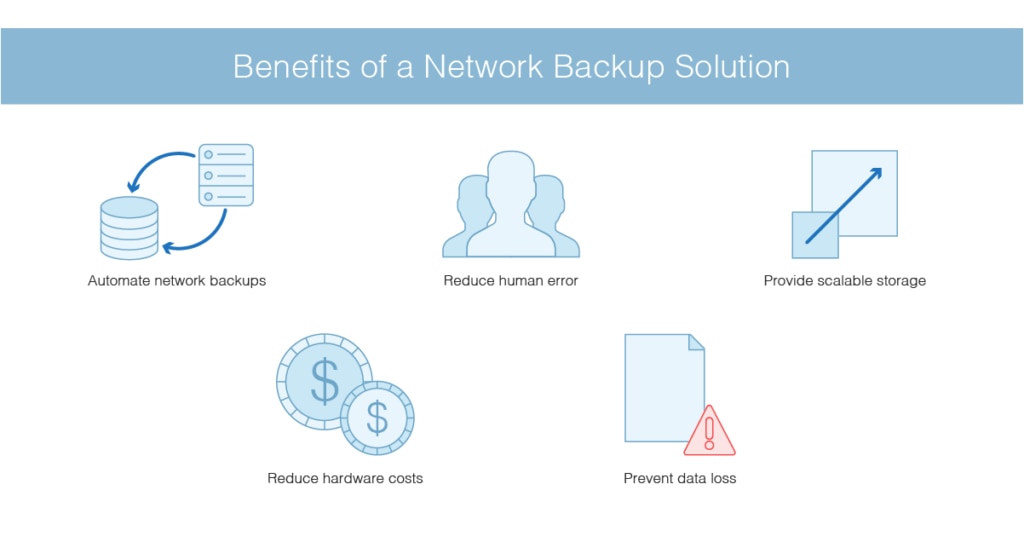
This image is property of www.dnsstuff.com.
## Best Practices for Network Data Backup
Define a Backup Strategy
To ensure the safety and availability of your critical data, it’s crucial to establish a comprehensive backup strategy. This involves determining what data needs to be backed up, how frequently backups should be performed, and where the backups will be stored. By defining a strategy tailored to your specific needs, you can efficiently protect your network data.
Regularly Test Restores
Regularly testing restores is a vital step in network data backup. It ensures that your backups are working correctly and that you can successfully recover your data when needed. By simulating a data loss scenario and restoring files from your backups, you can identify any issues or errors and address them proactively.
Implement Redundancy
Implementing redundancy is a smart practice for network data backup. By using multiple backup sources or storage locations, you reduce the risk of data loss due to hardware failure or other unforeseen events. Redundancy provides an additional layer of protection, ensuring that your data remains intact even in the event of a single backup failure.
Utilize Encryption
To safeguard your network data from unauthorized access, it is essential to utilize encryption during the backup process. Encryption transforms your data into an unreadable format that can only be deciphered with the appropriate encryption key. This adds an extra layer of security and ensures that even if your backups fall into the wrong hands, your data remains confidential.
Monitor Backup Performance
Monitoring backup performance allows you to proactively identify and address any issues that may arise. Pay attention to factors such as backup completion time, data transfer speed, and any error messages or warnings. Regular monitoring enables you to optimize your backup processes, ensuring that your network data is backed up efficiently and effectively.
Train Employees
Educating your employees on network data backup best practices is essential for maintaining data integrity. Provide training on how to perform backups, restore files, and follow backup policies and procedures. By ensuring that your employees understand the importance of data backup and their role in the process, you foster a culture of data protection and minimize the risk of accidental data loss.
By following these best practices, you can establish a robust network data backup system that safeguards your critical information and ensures its availability in the event of a system failure or data loss.
Network Data Backup vs Data Recovery
Difference between Backup and Recovery
When it comes to safeguarding your valuable data, understanding the difference between network data backup and data recovery is crucial. Network data backup refers to the process of creating duplicate copies of your data and storing them remotely, ensuring that they can be retrieved in case of accidental deletion, system failure, or other data loss incidents. On the other hand, data recovery focuses on retrieving lost or corrupted data from backup copies.
Relationship between Backup and Recovery
Backup and recovery go hand in hand, forming a reliable data protection strategy. Network data backup serves as a preventive measure, ensuring that your data is securely stored, while data recovery acts as a reactive measure to retrieve lost or damaged data from those backup copies.
In the event of data loss, your backup copies serve as a safety net, allowing you to restore your information and resume normal operations. This relationship between backup and recovery ensures that even if the worst happens, your valuable data is still recoverable, minimizing downtime and potential losses.
By implementing network data backup and understanding the seamless connection between backup and recovery, you can ensure the safety and availability of your critical data, providing peace of mind and the foundation for business continuity.
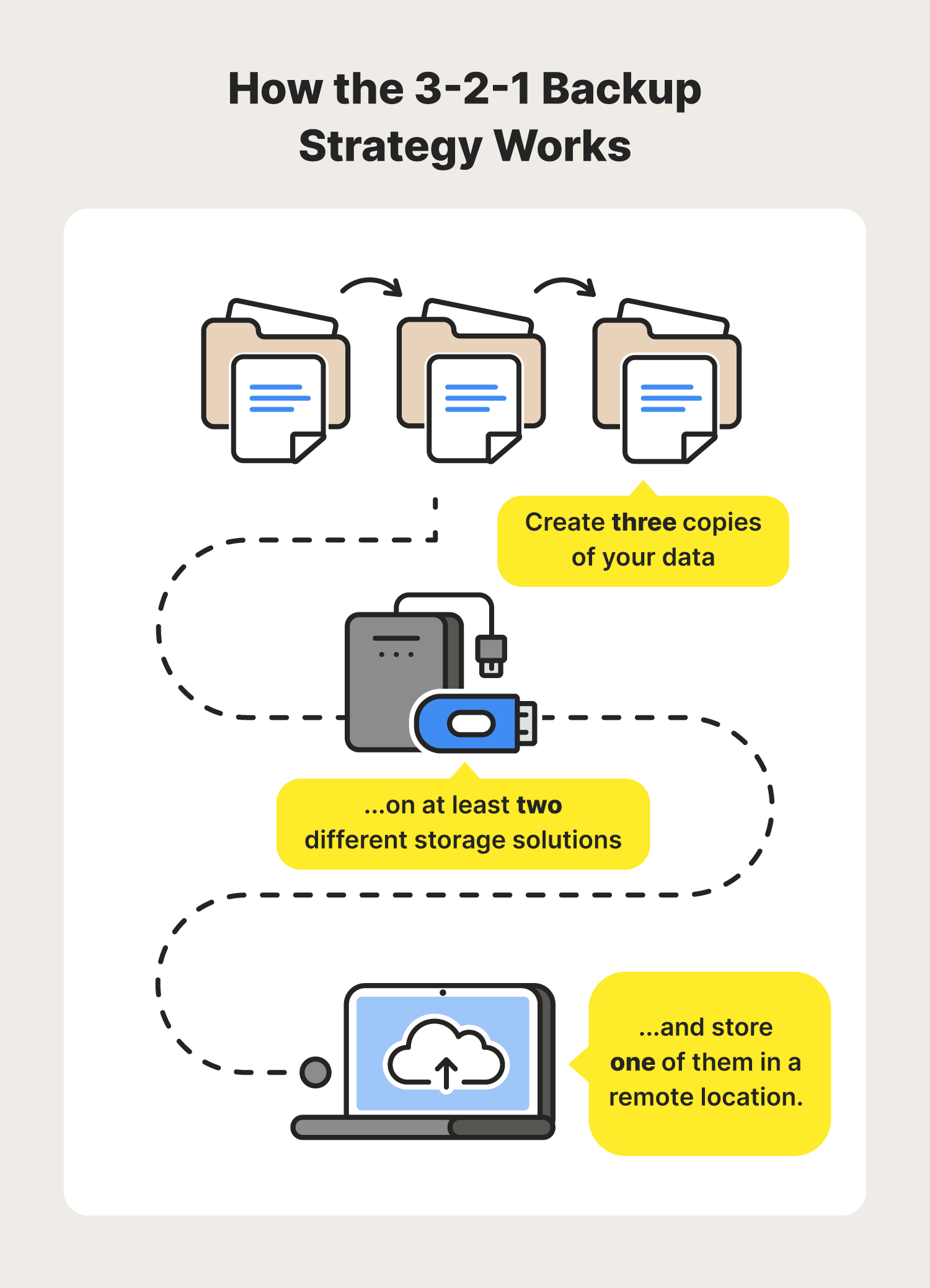
This image is property of us.norton.com.
## Network Data Backup Solutions
One of the most important aspects of protecting your valuable data is having a reliable network data backup solution in place. Network data backup refers to the process of creating duplicate copies of your data and storing them on a separate device or off-site location, ensuring that you can recover your data in the event of a disaster.
Leading Backup Software Providers
There are several reputable backup software providers that offer comprehensive network data backup solutions. These providers offer features such as automatic backups, scheduled backups, and the ability to backup multiple devices simultaneously. Examples of leading backup software providers include Acronis, Veeam, and Commvault.
Top Cloud Backup Services
Cloud backup services have gained popularity in recent years due to their convenience and scalability. These services utilize remote servers to store your data, allowing you to access it from anywhere with an internet connection. Among the top cloud backup services are Backblaze, Carbonite, and IDrive.
Popular Network Attached Storage (NAS) Devices
Network Attached Storage (NAS) devices are another popular choice for network data backup. These devices are standalone storage units that connect to your network and provide centralized data backup and storage. Some notable NAS devices include Synology, QNAP, and Western Digital.
By utilizing network data backup solutions, such as backup software, cloud services, or NAS devices, you can ensure the safety and accessibility of your important data in case of any unforeseen events.
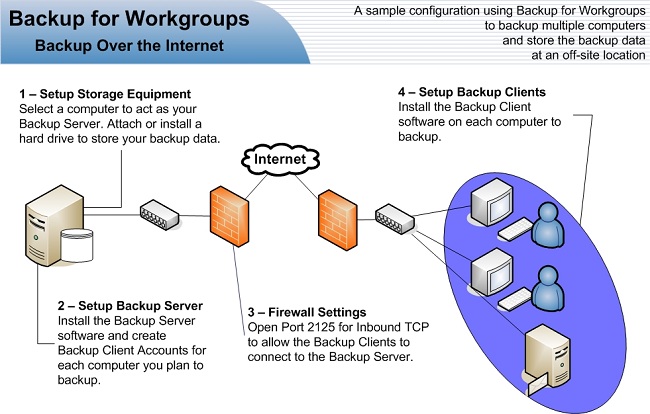
This image is property of www.backup-for-workgroups.com.
## Conclusion
In this article, you have learned about network data backup and how it works. Network data backup is a crucial process for safeguarding your valuable data and ensuring its availability in the event of a possible data loss.
With network data backup, your data is securely copied and stored in a centralized location, either on-premises or in the cloud. This ensures that even in case of hardware failure, natural disasters, or human error, your data remains safe and accessible.
Network data backup offers numerous benefits. Firstly, it provides data protection by minimizing the risk of data loss. Secondly, it allows for easy data recovery, ensuring that even if data is accidentally deleted or corrupted, you can restore it to its previous state. Additionally, network data backup enhances collaboration and data sharing among team members, as it allows multiple users to access the same set of data, promoting productivity and efficiency.
Network data backup typically involves the use of specialized software that performs regular backups of your data. These backups can be scheduled to occur automatically at specific intervals, or they can be manually initiated. The software collects and compresses the data, encrypts it for security, and then transmits it to the backup location. The backup data is stored in separate files or in a disk or tape storage system. When data recovery is needed, the backup software retrieves the necessary files and restores them to the appropriate location.
Overall, network data backup plays a critical role in preserving and protecting your important information. By implementing a network data backup strategy, you can ensure the safety and accessibility of your data, providing peace of mind and enabling you to focus on what matters most – your business.
